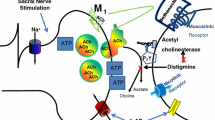Abstract
The normal bladder functions, storage and elimination of urine, are dependent on neural circuits in the brain and spinal cord that coordinate the activity of the detrusor and that of the smooth and striated muscles of the outflow region. Disturbances at different levels may cause the overactive bladder (OAB) syndrome, characterized by urge, frequency and urge incontinence. Knowledge about the mechanisms controlling both normal and abnormal micturition is mandatory for the detection of targets for pharmacological intervention. Such targets may be found in the central nervous system (CNS) or peripherally. Several CNS transmitters can modulate voiding, but few drugs with a defined CNS site of action have been demonstrated to be clinically useful. Traditionally, drugs for treatment of OAB have had a peripheral site of action. Antimuscarinics are still the gold standard, but their wellknown side effects have focused interest on other modalities of treatment. Promising preclinical results have been obtained for some principles, but so far there are few positive clinical proof of concept studies available.
Similar content being viewed by others
Author information
Authors and Affiliations
Rights and permissions
About this article
Cite this article
Andersson, K., Chapple, C. & Wein, A. The basis for drug treatment of the overactive bladder. World J Urol 19, 294–298 (2001). https://doi.org/10.1007/PL00007101
Issue Date:
DOI: https://doi.org/10.1007/PL00007101




